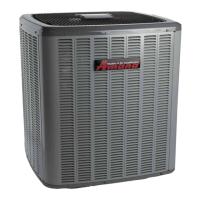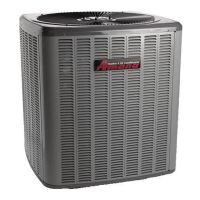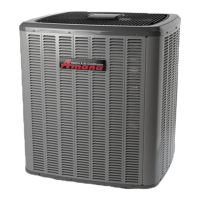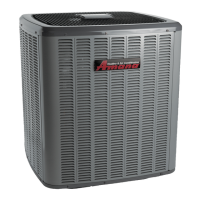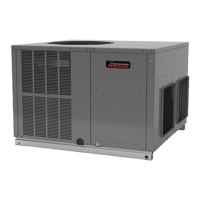SERVICING
57
Suction Line Drier Clean-Up Method
The POE oils used with R410A refrigerant is an excellent
solvent. In the case of a burnout, the POE oils will remove
any burnout residue left in the system. If not captured by
the refrigerant lter, they will collect in the compressor
or other system components, causing a failure of the
replacement compressor and/or spread contaminants
throughout the system, damaging additional components.
Install a eld supplied suction line drier. This drier should
be installed as close to the compressor suction tting as
possible. The lter must be accessible and be rechecked
for pressure drop after the system has operated for a
time. It may be necessary to use new tubing and form as
required.
1. Remove compressor discharge line strainer.
2. Remove the liquid line drier and expansion valve.
3. Purge all remaining components with dry nitrogen or
carbon dioxide until clean.
4. Install new components liquid line drier.
5. Braze all joints, leak test, evacuate, and recharge
system.
6. Start up the unit and record the pressure drop across
the drier.
7. Continue to run the system for a minimum of twelve (12)
hours and recheck the pressure drop across the drier.
Pressure drop should not exceed 6 PSIG.
8. Continue to run the system for several days, repeatedly
checking pressure drop across the suction line drier. If
the pressure drop never exceeds the 6 PSIG, the drier
has trapped the contaminants. Remove the suction line
drier from the system.
9. If the pressure drop becomes greater, then it must be
replaced and steps 5 through 9 repeated until it does
not exceed 6 PSIG.
The piping of a refrigeration system is very important in
relation to system capacity, proper oil return to compressor,
pumping rate of compressor and cooling performance of
the evaporator.
POE oils maintain a consistent viscosity over a large
temperature range which aids in the oil return to the
compressor; however, there will be some installations
which require oil return traps. These installations should
be avoided whenever possible, as adding oil traps to the
refrigerant lines also increases the opportunity for debris
and moisture to be introduced into the system. Avoid long
running traps in horizontal suction line.
ALUMINUM INDOOR COIL CLEANING
(QUALIFIED SERVICER ONLY)
This unit is equipped with an aluminum tube evaporator
coil. The safest way to clean the evaporator coil is to simply
ush the coil with water. This cleaning practice remains as
the recommended cleaning method for both copper tube
and aluminum tube residential cooling coils.
An alternate cleaning method is to use one of the products
listed in the technical publication
to clean the coils. The
cleaners listed are the only agents deemed safe and
approved for use to clean round tube aluminum coils. TP-
109 is available on the web site in Partner Link > Service
Toolkit.
AIR HANDLER STATIC PRESSURE READINGS
To determine proper airow, proceed as follows:
1. Using a Inclined Manometer or Magnehelic gauge ,
measure the static pressure of the return duct at the
inlet of the air handler, this will be a negative pressure (
for example -.30”wc)
2. Measure the static pressure of the supply duct at
the outlet of the air handler, this should be a positive
pressure (for example .20”wc).
3. Add the two readings together (for example -.30”wc +
.20”wc = .50”wc total external static pressure.
4. Consult proper air handler airow chart for quantity of
air (CFM) at the measured external static pressure.
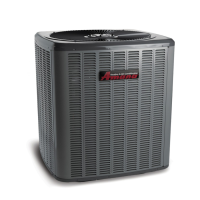
